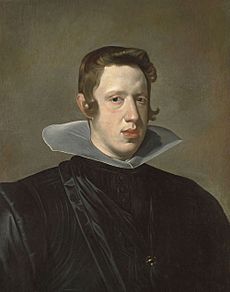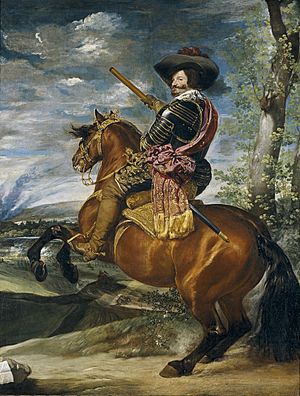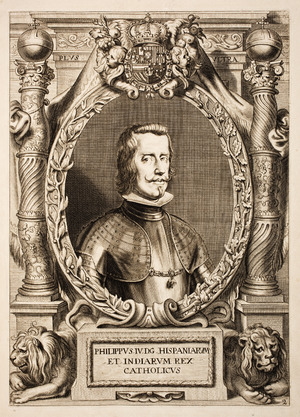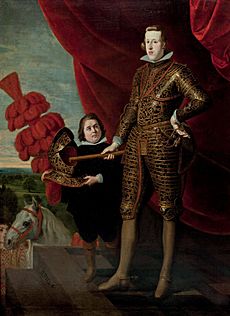Philip IV of Spain facts for kids
Quick facts for kids Philip IV |
|||||
|---|---|---|---|---|---|

|
|||||
| King of Spain (more...) | |||||
| Reign | 31 March 1621 – 17 September 1665 | ||||
| Predecessor | Philip III | ||||
| Successor | Charles II | ||||
| Lord of the Netherlands | |||||
| Reign | 31 March 1621 – 17 September 1665 | ||||
| Predecessor | Isabella & Albert | ||||
| Successor | Charles II | ||||
| Governors |
See list
|
||||
| King of Portugal | |||||
| Reign | 31 March 1621 – 1 December 1640 | ||||
| Predecessor | Philip III (as Philip II of Portugal) | ||||
| Successor | John IV | ||||
| Viceroys |
See list
|
||||
| Born | 8 April 1605 Royal Palace of Valladolid, Valladolid, Spain |
||||
| Died | 17 September 1665 (aged 60) Madrid, Spain |
||||
| Burial | El Escorial | ||||
| Spouse |
|
||||
| Issue Detail |
|||||
|
|||||
| House | Habsburg | ||||
| Father | Philip III of Spain | ||||
| Mother | Margaret of Austria | ||||
| Religion | Roman Catholicism | ||||
| Signature |  |
||||
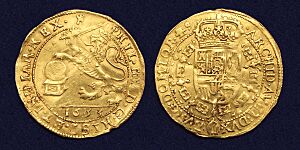
Philip IV (born April 8, 1605, died September 17, 1665) was the King of Spain from 1621 until his death. He was also the King of Portugal (as Philip III) from 1621 to 1640. People sometimes called him the Planet King. Philip is well-known for supporting the arts, including famous painters like Diego Velázquez. He ruled Spain during the important Thirty Years' War.
When Philip IV died, the Spanish Empire was huge, covering about 12.2 million square kilometers (4.7 million square miles). However, in other ways, the empire was becoming weaker. Philip's rule contributed to this decline because he struggled to make successful changes at home and in the military.
Contents
Philip IV's Early Life and Family

Philip IV was born in the Royal Palace of Valladolid, Spain. He was the oldest son of Philip III and Margaret of Austria. In 1615, when Philip was 10, he married 13-year-old Elisabeth of France.
Philip and Elisabeth had ten children, but only one son, Balthasar Charles, survived past infancy. Balthasar Charles died at age sixteen in 1646. His death greatly saddened the king. Elisabeth worked with other Spanish nobles to remove Olivares, Philip's main minister, from court in 1643. For a short time, she had a lot of influence over Philip.
After Elisabeth and his only son died, Philip remarried in 1649 at age 44. His second wife was his niece, 14-year-old Maria Anna (also known as Mariana). This marriage was important for politics and to strengthen ties with the Habsburg family in Austria. Mariana gave birth to five children. Only two survived to adulthood: a daughter, Margarita Teresa, born in 1651, and the future Charles II of Spain, born in 1661. Charles II was often sick, which made the line of succession uncertain.
Philip's Personality and Royal Role
Historians' views of Philip's personality have changed over time. Earlier writers saw him as a weak ruler who let his ministers do too much. However, 20th-century historians have a more positive view, noting he had more energy than his father.
Philip was seen by people at the time as a perfect example of a Baroque king. In public, he was very serious and calm. Visitors said he looked like a statue and rarely laughed. Philip felt strongly about his "royal dignity." His minister, Olivares, taught him how to act like a Baroque ruler. This public image was a key political tool for Philip. He was also a skilled horseman, a keen hunter, and loved bull-fighting, which were important parts of royal life.
In private, Philip seemed to have a lighter side. When he was younger, he was known for his good humor. He often attended "academies" in Madrid, which were informal gatherings to discuss literature and poetry in a fun way. He loved theater, and some people criticized him for enjoying these "frivolous" entertainments. Those close to him described him as kind, gentle, and friendly. They also said he was smart, knew Latin and geography well, and could speak French, Portuguese, and Italian. He was interested in astrology, like many people of his time.
Philip had a strong Catholic faith, especially later in his reign. He became very focused on religious matters. He exchanged many letters with a respected nun, Sor María de Ágreda, seeking her advice.
Philip and His Ministers

When Philip IV became king, the royal court was changing. A new group of nobles, led by Don Baltasar de Zúñiga, wanted to reduce the power of the Sandoval family. De Zúñiga introduced his nephew, Olivares, to Prince Philip. Olivares was ten years older than Philip.
At first, Philip did not like Olivares much. But over time, their relationship grew very close. Philip tended to be unsure of himself, and Olivares was very driven and determined. Olivares quickly became Philip's most trusted advisor. When Philip became king in 1621 at age sixteen, he showed his trust by ordering that all royal papers go to Olivares first. Philip kept Olivares as his main minister for the next twenty years.
Philip and Olivares worked closely together. Philip would often meet with Olivares to discuss the day's business. Some historians now believe Philip paid more attention to making decisions than was once thought. Their close bond was so strong that their portraits were placed side by side at the Buen Retiro palace, which was very unusual at the time. However, their relationship was not always smooth; they had many arguments.
Philip wanted to reform the monarchy to be more serious and moral, like it was under his grandfather, Philip II. Olivares suggested a "Union of Arms" to create a large army supported by fair taxes from across the empire. This idea was very forward-thinking, but it faced strong opposition from different regions and was eventually dropped.
The costs of the Thirty Years' War put a lot of pressure on Spain. Philip and his government tried to reduce government spending. They also sold off royal lands and rights to pay for the war.
In 1640, a major crisis hit. Olivares's attempt to deal with a French invasion threat in Catalonia led to a revolt. Then, when he tried to get Portugal's nobles to support the war, it caused another uprising. The nobles in Lisbon removed Philip from power, ending 60 years of Spain ruling Portugal. This started the Portuguese Restoration War.
Philip was very shaken by these events. In 1643, he removed Olivares from office to try and make peace with the Spanish nobles. He announced he would rule alone. However, he eventually returned to ruling through a trusted minister. Luis de Haro, Olivares's nephew, became the new minister.
Foreign Policy and the Thirty Years' War
Philip ruled during most of the Thirty Years' War, a very difficult time in European military history. Philip and Olivares decided Spain should have a more aggressive foreign policy, working with the Holy Roman Empire. This meant restarting fighting with the Dutch in 1621 to get a peace treaty that favored Spain. Philip's government focused on the Netherlands first until 1643. Philip did not seem to enjoy war, noting that with such a large empire, war was always happening somewhere.
The 1620s were good for Spain's foreign policy. The war with the Dutch went well, even though it was expensive. Spain even recaptured the important city of Breda in 1624. However, by the end of the decade, Spain faced a choice: focus on the war in Flanders or its relationship with France during the War of the Mantuan Succession (1628–1631). Philip's advisors chose to prioritize Flanders, which angered Louis XIII of France.
Even with Spanish successes in the mid-1630s, like defeating Swedish-led forces at the Battle of Nördlingen in 1634, tensions with France grew. War between the two Catholic countries became unavoidable. Olivares told Philip that the coming war with France would be a fight for everything; Spain would either win or fall.
The Spanish-French war began in 1635. Early Spanish victories even threatened Paris. But from 1640 onwards, Spain struggled to keep fighting due to widespread revolts across its territories. Philip changed his strategy, cutting resources for the army in Flanders to focus on the French-backed rebels in Catalonia.
After a major Spanish defeat at Rocroi, Philip sought a peace treaty. The Peace of Westphalia in 1648 ended the Eighty Years' War in the Netherlands and the wars in Germany. However, the conflict with France continued. Philip decided to keep fighting when France faced its own internal rebellions (the Fronde). He personally led a successful attack against the French in Catalonia in 1651.
True victory over France never came. By 1658, after losing Dunkirk, Philip desperately wanted peace. The Treaty of the Pyrenees in 1659, and the marriage of Philip's daughter Maria Theresa to the young King Louis XIV, finally ended the war with France. However, the war against Portugal continued as Philip tried to regain control of his lost kingdom.
Philip and the Spanish Military
By the late 1620s, the Spanish army was not as strong as it used to be. The famous tercio regiments, with their disciplined pikemen, seemed old-fashioned compared to newer Swedish and Dutch armies that used more musketeers. Philip and Olivares tried to fix these problems. They believed the army lacked good leaders. Philip agreed to try and get more nobles to join the military's higher ranks.
However, this didn't work as well as they hoped. Many nobles didn't want to spend years learning military skills. They wanted to become generals right away. By the 1630s, the king had to change rules to allow faster promotions and pay higher salaries to get nobles to take on these roles. The performance of these officers in battles like Rocroi was often disappointing.
Philip was also very interested in the Spanish navy. Soon after becoming king, he greatly increased the size of his fleets. He doubled, then tripled, the navy's budget. Philip is praised for his "sensible, practical approach" to managing the navy. He paid attention to many details of naval policy. Even after the terrible Battle of the Downs, Philip remained very interested in his navy. He believed that land and sea operations were essential together.
Philip's Patronage of the Arts

Philip is remembered for his great love of art and theater. For the stage, he favored famous playwrights like Lope de Vega and Pedro Calderón de la Barca. Philip even helped write some comedies himself. Court theater used new inventions from Italy, like perspective scenery, which was not common in public theaters then.
Philip became famous for supporting his court painter, Diego Velázquez. Velázquez was from Seville and became known to Olivares. Philip called Velázquez to Madrid in 1624. Despite some jealousy from other painters, Velázquez quickly became successful with Philip. He worked for the king until his death, even painting a celebration of the Treaty of the Pyrenees for Philip. The king and Velázquez shared interests in horses, dogs, and art, and they had a relaxed friendship. Philip also supported other important painters. He collected over 4,000 paintings by the time he died, an amazing collection.
Philip was called el Rey Planeta, the 'Planet King', by people at the time. Much of the art and displays at his court were meant to show his power and authority to both Spaniards and foreigners. The art and symbols of the time did not show the real decline of Spanish power. In fact, the few Spanish military successes were celebrated greatly by royal artists. Many artists from the Spanish Netherlands created works praising the Army of Flanders. The recapture of Breda alone led to major works by Velázquez and others.
The 'Planet King' also built a new palace to display his art and for court events. Through Olivares, Philip started building the Buen Retiro palace in Madrid. Work began in 1631, and the magnificent 'Hall of Thrones' was finished by 1635. The palace had its own theater, ballroom, galleries, bull ring, gardens, and artificial lakes. It became a center for artists and writers from all over Europe. This palace was built during a difficult time for Philip, when Spain was at war. Despite its high cost, it was an important way to show royal greatness and power.
Philip's Religious Beliefs
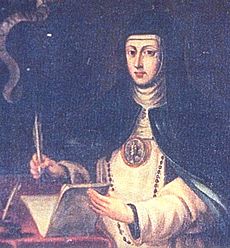
The Catholic religion was very important in Philip's life, especially later in his reign. He became more focused on religious matters as he felt depressed by events across his empire. Philip was especially devoted to a painting called Nuestra Señora del Milagro (Our Lady of the Miracle). People believed the painting's eyes would move in response to prayers.
Philip also played a key role in the process of making people saints. He used this to help his country. For example, he strongly supported making Isabella of Portugal, a 14th-century queen, a saint. This helped him connect with his Portuguese subjects. It was also important for Spain's reputation to have many new saints, especially compared to Catholic France. Philip supported many writings and books to promote Spain's candidates for sainthood.

During the crisis of 1640–1643, Philip seemed to have a crisis of faith. He truly believed that God judged his actions based on whether his policies succeeded or failed. The revolts, French advances, and losing his trusted minister Olivares deeply affected him.
Philip later turned to a well-known nun and mystic, Sister María de Ágreda. He asked her to write to him and advise him on spiritual matters. They wrote to each other regularly for 22 years, exchanging over 600 letters. Philip believed that Maria could speak with God on his behalf and advise him on what God wanted him to do to improve Spain's situation.
Philip IV's Legacy
Philip IV's reign, after some early successes, was marked by many political and military challenges. He is sometimes blamed for Spain's decline, but many of these problems were large issues beyond the control of any one ruler. Philip IV died in 1665. He hoped that his surviving son, Charles II, who was only 4 years old, would have better luck than him.
In his will, Philip left political power to his wife Mariana, who would act as regent for the young Charles II. He instructed her to follow the advice of a small committee. This committee did not include John Joseph, Philip's son from outside his marriages. This led to a struggle for power between Mariana and John Joseph until John Joseph's death in 1679.
Family Life and Children
- With Elisabeth of France (married 1615):
- Maria Margaret of Austria, Infanta of Spain (born and died 1621)
- Margaret Maria Catherine of Austria, Infanta of Spain (born and died 1623)
- Maria Eugenia of Austria, Infanta of Spain (1625–1627)
- Isabella Maria Theresa of Austria, Infanta of Spain (born and died 1627)
- Balthasar Charles of Austria, Prince of Asturias (1629–1646). He was the heir to the throne.
- Infanta Maria Anna "Mariana" Antonia of Austria, Infanta of Spain (born and died 1636)
- Maria Theresa of Austria, Infanta of Spain (1638–1683). She married Louis XIV of France and had children.
- With Archduchess Maria Anna of Austria (married 1649):
- Margaret Theresa of Austria, Infanta of Spain (1651–1673). She married Leopold I, Holy Roman Emperor.
- Infanta Maria Ambrosia de la Concepción of Austria, Infanta of Spain (born and died 1655)
- Philip Prospero of Austria, Prince of Asturias (1657–1661). He was the heir after Balthasar Charles.
- Ferdinand Thomas Charles of Austria, Infante of Spain (1658–1659)
- Charles II of Spain (1661–1700). He became King of Spain.
- With María Calderón:
- John Joseph of Austria (1629–1679). He was raised as a royal prince.
Images for kids
See also
 In Spanish: Felipe IV de España para niños
In Spanish: Felipe IV de España para niños




